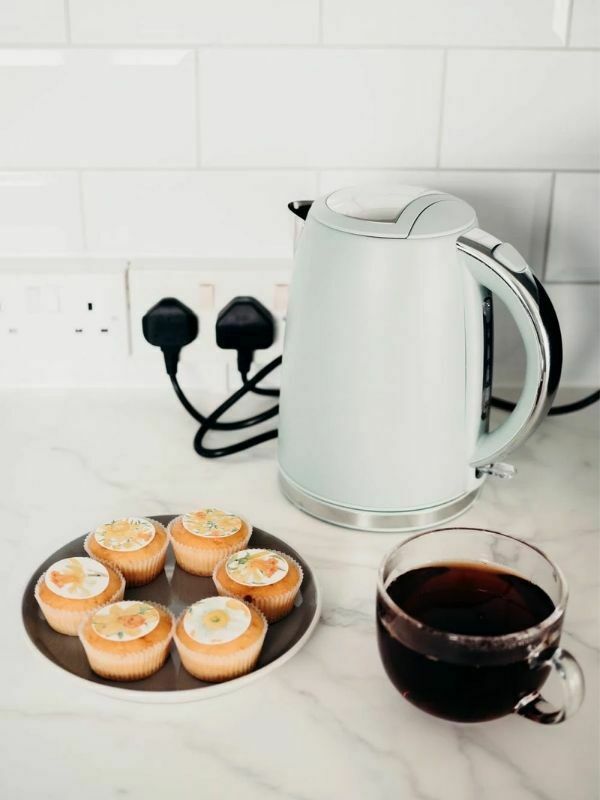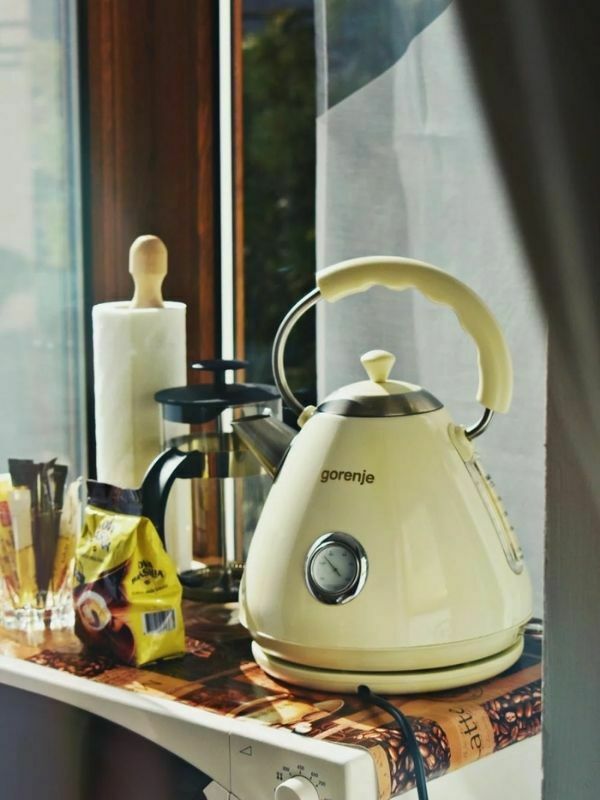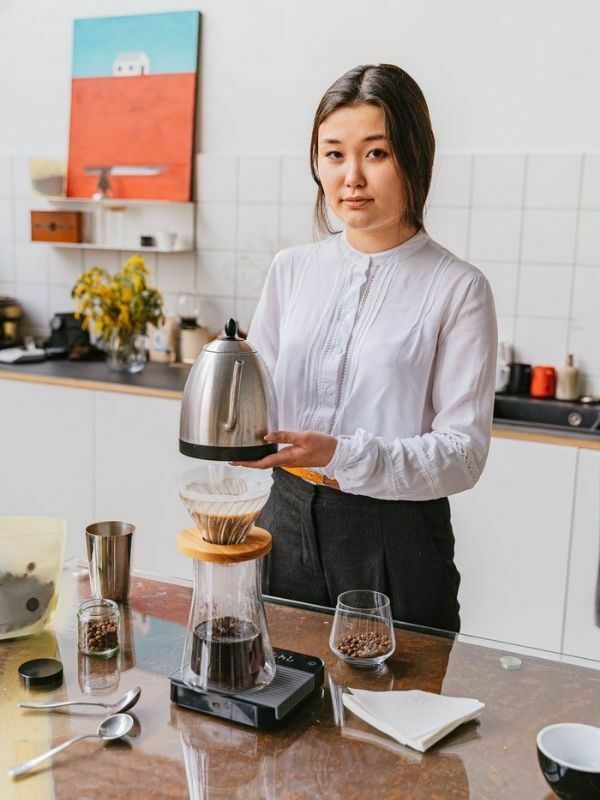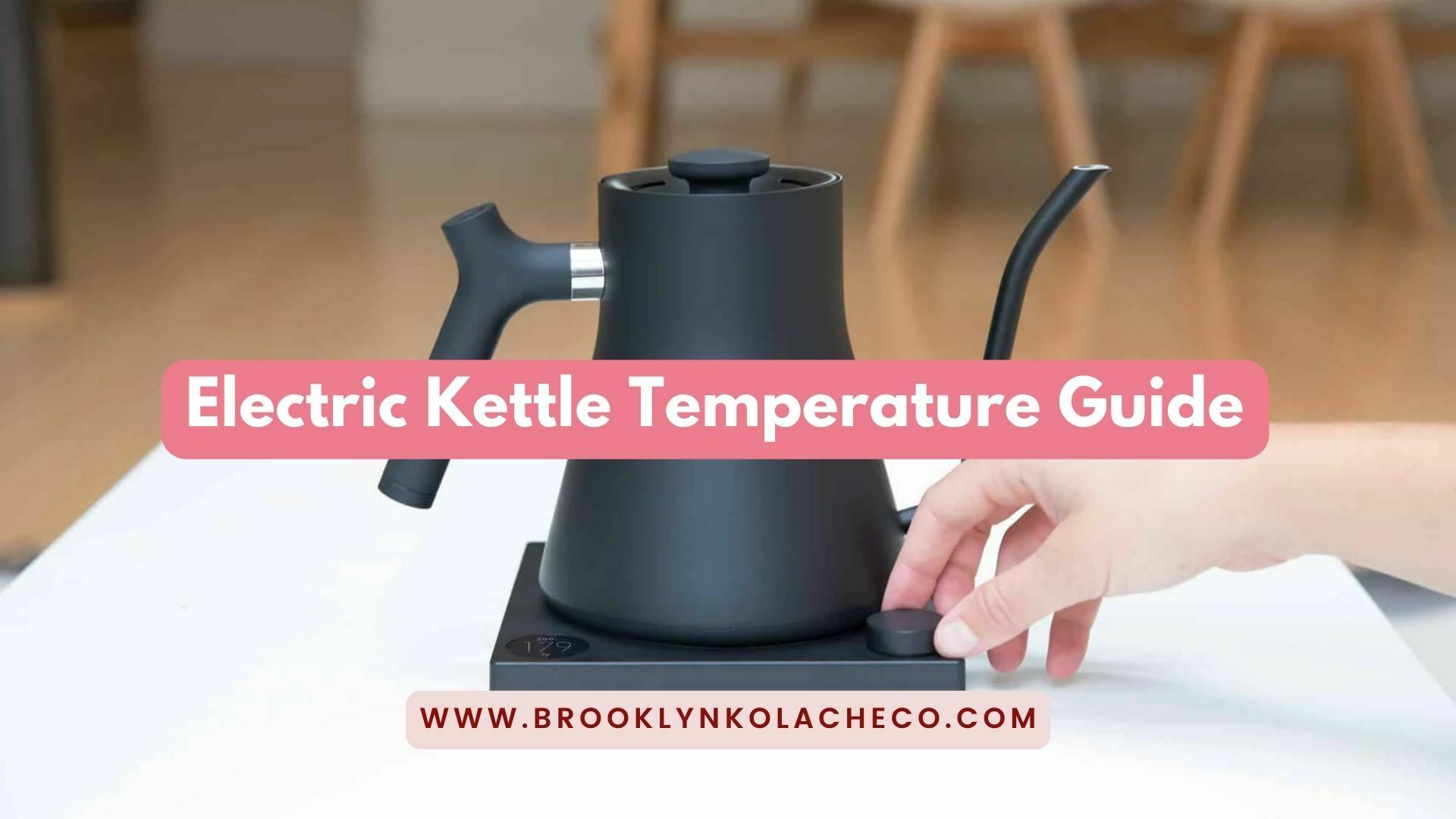If you are a tea drinker, or perhaps just want to make some soothing herbal tea without the need for a stovetop kettle and teapot, then the electric kettle is right up your street. The most commonly marketed brands include Morphy Richards, KitchenAid, and Russell Hobbs while cheaper equivalents can be found such as Swan or DeLonghi. You can find out which one is right for you in this electric kettle temperature guide.
What is An Electric Kettle?
A kettle is a small appliance that is used to heat water. The electric kettle was invented in 1891 and has been a staple in many kitchens since. Electric kettles are very similar to stovetop tea kettles except that they have an internal heating mechanism for boiling the water.

Electric kettles can boil water much faster than stovetop kettles, especially on induction burners. They also bring the temperature to a precise level. If you like to brew tea, you know that different types of tea need different temperatures to brew properly. Green tea, for instance, will taste bitter if brewed at boiling temperature.
An electric kettle consists of three parts: the heating element, the thermostat that regulates temperature, and the kettle itself. Electric kettles come in stainless steel or plastic varieties; plastic kettles are more popular because they are less expensive, but they can leach chemicals into the water if they are overheated (many plastic kettles have a maximum fill line).
How to Use One
Electric kettles have become very popular because they are quick to use and easy to maintain. They can be used to heat water for a variety of purposes, from making coffee and tea to preparing instant soups and noodles. They can also be used to boil eggs and sterilize bottles when you are preparing food for babies.
Using an electric kettle is extremely simple, and if you follow these steps, you can heat up your water in a matter of minutes:
- Fill the kettle with water.
- Plug the kettle into an outlet.
- Turn the kettle on by pressing the “On” switch or button on the front of the device.
- Wait for the water to boil. Listen for the whistle or watch for the automatic shut-off once it boils.
- Unplug the kettle from the wall once it has turned itself off or when you hear it whistle if your model does not automatically turn off after boiling.
- Pour out only as much water as you need at that time and leave the rest in the kettle if you do not plan on using it right away, but do not leave more than a few cups in there as that could lead to bacteria growth inside it if you do not use it right away
Electric Kettle Temperature Guide
If you love to brew tea, an electric kettle is a must-have kitchen gadget. It’s the fastest and simplest way to boil water for the perfect cup or pot of tea. You can also use an electric kettle to heat up water quickly for hot chocolate, instant coffee, and other drinks that require hot water.

Here’s our quick guide to common temperatures in electric kettles:
1. Lower than 160℉ (71℃)
Water at this temperature is perfect for brewing white teas to their full potential.
2. 160℉ (71℃)
This is the ideal temperature range for brewing premium leaves of green tea. The water will be hot, but not so hot that it scorches the leaves and creates an overly bitter taste.
3. 170℉ (77℃)
This temperature range is perfect for most green or white teas. It is too low for black or oolong tea and will not extract enough flavor from the leaves.
4. 185℉ (85℃)
This temperature range is perfect for brewing most types of black tea, including Earl Grey and English Breakfast.
5. 195℉ (91℃)
This temperature range is also good for black tea, but some varieties of black tea, like Darjeeling and Ceylon, are better brewed at a lower temperature to avoid tasting overly bitter.
6. 200℉ (93℃)
This temperature range can be used to brew any type of tea, instant coffee, or hot chocolate. But boiling water can scald.
7. 212° F (100°C)
Most electric kettles will automatically shut off once they reach 212°F (100°C), which is ideal for black tea, green tea, white tea, Pu-erh tea, and herbal teas are all brewed at this temperature.
6 Safety Tips for Using an Electric Kettle
Electric kettles are a staple in many households, but they can be dangerous if used incorrectly. Here are three key tips for using electric kettles safely in your home.
1. Don’t touch the hot surface of an electric kettle.
Electric kettles can get very hot, especially when they are full of water. Always keep your hands away from the hot surface and handle the kettle with care. If you do accidentally touch the hot surface, quickly run cold water over the affected area.
2. Don’t fill an electric kettle with more than 1 liter of water.
Filling an electric kettle with too much water can cause it to boil over or, worse, explode. Never fill an electric kettle beyond its 1-liter capacity.
3. Don’t put anything other than water in an electric kettle.
Some people like to steep tea directly in their kettle, but this is not recommended by most manufacturers. Only put water in your electric kettle, as other liquids could damage it and make it unsafe to use.
4. Keep the Electric Kettle Away from Children
Electric kettles can be dangerous for young children and pets because of how hot their contents get. You should always keep your electric kettle out of reach of children, and you should never let them use an electric kettle without supervision. Make sure that you put your electric kettle away in a cabinet when it’s not in use so that small hands can’t reach it when you’re not paying attention.
5. Never use the kettle if it is damaged
If you see any damage to your electric kettle, you should immediately stop using it and get a new one. Never try to repair it yourself or take it to a local repairman as the circuit might be damaged and the appliance can cause an electric shock to you or even catch fire.
6. Always place your kettle on a flat, dry surface
Place your kettle on a flat, dry surface so that it has proper stability while boiling water. Do not tilt or lean your kettle while boiling water and also do not place anything on top of it to avoid any accidents.
7 Electric Kettle Tricks
You know how electric kettles can heat water to the perfect temperature in no time? Potentially life-changing, right? But it turns out that they can be used for more than just tea.
Don’t wait for a rainy day. Check out these seven electric kettle tricks that are guaranteed to make your life easier!
1. Make Coffee

If you’re looking for a quick and easy way to make coffee while camping, look no further than your electric kettle. Simply fill the kettle with water and ground coffee, let it steep for a few minutes, then strain the grounds using a coffee filter or strainer.
2. Steam Vegetables
Boil water in the kettle, then pours it into a saucepan with chopped vegetables. Cover and cook for three to four minutes, or until the vegetables are tender.
3. Make quick hard-boiled eggs.
Fill your kettle with cold water and put in some eggs (don’t forget this step because you don’t want to crack them). Bring the water to a boil, then shut off the kettle, put on the lid, and let it sit for 10 minutes for soft-boiled eggs or 15 minutes for hard-boiled eggs. Drain out the hot water and run cold water over the eggs until they’re cool enough to handle (about 30 seconds).
4. Make Oatmeal or Ramen
Hot cereal lovers can also take advantage of electric kettles’ speed by pouring boiling water over their favorite oats, along with any fruit or nuts they might want to add.
5. Sterilize Sponges and Scrub Brushes
Boil sponges, scrub brushes, and even toothbrushes in the electric kettle to sanitize them. Simply fill up your kettle with water, let it boil, and then leave it on for two minutes more. Unplug it, let it cool enough to handle safely, and then carefully pour the boiling water into a container. Drop in whatever you wish to sterilize and soak for five minutes before using as normal.
6. Soften Butter
Don’t want to wait for butter to come to room temperature? Fill your kettle with hot tap water and set it on its base. Set a bowl of cold butter on top of the kettle; after about 20 minutes it will be soft enough for spreading or baking purposes.
7. Make instant noodles
You can reduce the time it takes to make instant noodles by boiling water in an electric kettle. Just place the noodles and flavor packet in a large bowl, then add the required amount of water. Wait 5-10 minutes, and your ramen is ready to eat!
FAQs
1. How to use a kettle to make tea quickly and etiquette?
Some people have found a great way to make tea quickly. They use an electric kettle to make tea. The best electric kettles will heat water to the right temperature in just minutes.
2. What temperature should I set to make oatmeal?
Set the Kettle to 180°f (82°c) for Oatmeal and Cracked Grains.
3. Can you heat baby food in an electric kettle?
The easiest way to prepare baby formula is with bottled water from the store, but if you’d like to use tap water, make sure it’s been boiled for at least one minute and cooled before mixing it with formula. If you need to warm the formula that’s already been mixed, pour it into a bottle and place it in a bowl of warm water for about 10 minutes.
4. How long does it take to boil water in an electric kettle?
It depends on the size of the kettle and how much water you’re boiling, but typically less than five minutes. Electric kettles are convenient because they’ll automatically shut off when the water reaches its boiling point, so there’s no risk of accidentally burning or overheating your baby’s food.
5. Concerned about the age of your electric kettle?
The first thing to keep in mind is that electric kettles are not like fine wine: they do not age well. At least not the parts you can see. If you have an older model that is showing signs of wear, it’s best to replace it as soon as possible. Electric kettles don’t have a lot of moving parts, so they don’t need a lot of maintenance. But they do have one piece that has to be replaced every couple of years or so: the heating element. And this makes sense: after all, it’s the element that does all the work in an electric kettle!
6. When should I replace my electric kettle?
You can tell that your electric kettle needs to be replaced when:
- Its water capacity has been reduced by half.
- It has discolored.
- It is developing rust.
- It is leaking water.
In summary
Here is a general guide for temperature ranges that electric kettles will reach at certain power settings. Through my guide, I hope that you have the information you need to find and purchase the correct kettle. Please enjoy it, and help share this resource with someone who might benefit from it as well!
